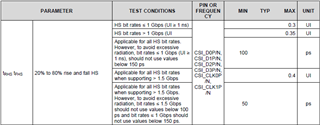Hi Team,
What can you tell me about tRHS and tFHS as described in the data sheet?

Will this standard RISE and FALL for differential waveforms?
Or are they rise and fall for single-ended P and N observations?
If you have a FIGURE, please provide it.
I checked by myself and found the following waveform on the Teledyne website.
Are tRHS and tFHS correct for this waveform observation method?
(I call this waveform single-ended observation).

Best Regards,
Masanori


